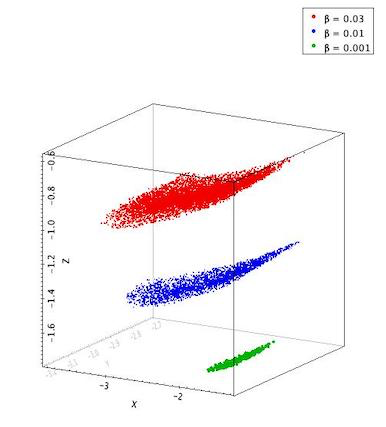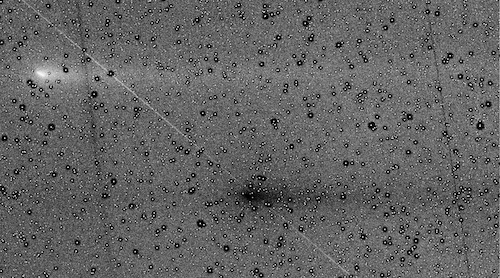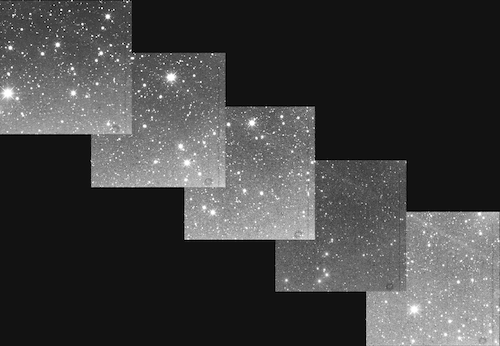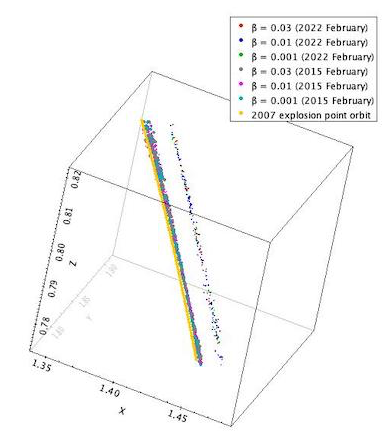Dust Trail Observations of Comet 17P/Holmes and Predictions for 2021-2022
- 1Finnish Fireball Network, Ursa Astronomical Association, Kopernikuksentie 1, FI-00130 Helsinki, Finland (markku.nissinen@pp.inet.fi)
- 2Finnish Geospatial Research Institute (FGI), Geodeetinrinne 2, FI-02430 Masala, Finland (maria.gritsevich@helsinki.fi)
- 3Department of Physics, University of Helsinki, Gustaf Hällströmin katu 2a, P.O. Box 64, FI-00014 Helsinki, Finland (maria.gritsevich@helsinki.fi)
- 4Institute of Physics and Technology, Ural Federal University, Mira str. 19., 620002 Ekaterinburg, Russia (maria.gritsevich@helsinki.fi)
- 5Hankasalmi observatory, Jyväskylän Sirius ry, Verkkoniementie 30, 40950 Muurame, Finland (arto.oksanen@jklsirius.fi)
- 6Clayhole observatory, Jokela, Finland (suomela20@gmail.com)
1. Introduction
When the comet 17P/Holmes' outburst [1] took place on 2007 October 23-24 [2] a large number of dust particles and gas were ejected from the comet [7].
The dust particles ended up on elliptic orbits around the Sun and seemingly vanished. However, there are two common nodes of the orbits, where dust particles converge [6].
2. Observations
Our first observations of the dust were made in February 2013.
The second observation was made in August 2013. (Fig. 1 & 2) [3]. Particle radius 1 mm corresponds to β value 0.001, particle radius 0.1 mm corresponds to β value 0.01 and particle radius 0.03 mm corresponds to β value 0.03.
Figure 1. Modeling and observation 2013 August 24.

Figure 2. Modeling of dust trail 2013 August 24.
Observations were continued in September 2014 (Fig. 3) [4].

Figure 3. Comet 17P/Holmes pictured when traveling on top of the dust trail.
In February 2015 dust trail was visible without image subtraction (Fig. 4) [5].

Figure 4. Observation 2015 February 14 in Hankasalmi Observatory.
3. Predictions
The dust trail particles are modelled using our software named the ‘Dust Trail kit’.
This model can be used also for calculating predictions for meteor streams that hit Earth’s atmosphere [8].
In Fig. 5 Comet is plotted on top of the modeled trail section for September 6 2021.
Figure 5. Comet 17P/Holmes plotted on top of the modeled trail.
The density of small particles is not increasing significantly until well into 2022 (Fig. 6).
The physical dust trail will move towards the original explosion point. Width of the trail seen from Earth is comparatively similar with 2015 February observations in 2022 February and March. Particle density is comparatively similar also. All particle sizes are present in the trail near the explosion point. Big particles are located in large abundance at the physical center of the trail.

Figure 6. Prediction of the dust trail in February 2022 near the explosion point. Marked in the picture is 17P/Holmes orbit at explosion event, modeled 2015 February trail and 0.01 AU further away modeled 2022 February trail. Density in the model is 15000 particles for each beta for 2015 and 4000 particles for each beta for 2022.
4. Conclusions
According to our theoretical results the dust trail will be detectable in visible light even when observed by modest aperture telescopes, although it may require the use of image subtraction. Interplanetary dust at the predicted time and coordinates will also be bright in mid infrared.
Acknowledgements
We express deep gratitude to Esko Lyytinen for initiating this research and for putting in place effective collaboration under the umbrella of the Ursa Astronomical Association and the Finnish Fireball Network. We thank Salli and Olli Lyytinen for sharing the material for this research from Esko Lyytinen’s personal archive and computers. We believe this allowed us to provide a comprehensive representation of the dust trail evolution research ideas that were earlier described to us by Esko in the form of personal communications, emails and notes. We are grateful to Pekka Lehtikoski for his contribution to the programming of the mathematical model. This work was supported, in part, by the Academy of Finland project no. 325806 (PlanetS).
Dedication
This presentation is dedicated to the memory of mastermind Esko Lyytinen who did a tremendous amount of original research, modeling, and predictions of meteor streams for the scientific community.
References
[1] Lin Z. Y., Lin C. S., Ip W. H. and Lara L. M. (2009). “The Outburst of Comet 17P/Holmes”. The Astronomical Journal, Volume 138, Number 2.
[2] Sekanina Z. (2009). “Comet 17P/Holmes: A Megaburst Survivor”, International Comet Quarterly, pp. 5-23.
[3]Lyytinen E., Nissinen M. and Oksanen A. (2015). “Dust Trail of Comet 17P/Holmes”. ATel 7062.
[4] Lyytinen E., Nissinen M., Lehto H. J. and Suomela J. (2014). “Dust Trail of Comet 17P/Holmes”. CBET 3969.
[5] Lyytinen E., Lehto H. J., Nissinen M., Jenniskens P. and Suomela J. (2013). “Comet 17P/Holmes Dust Trail”. CBET 3633 #1.
[6] Lyytinen E., Nissinen M. and Lehto H. J. (2013). “Comet 17P/Holmes: originally widely spreading dust particles from the 2007 explosion converge into an observable dust trail near the common nodes of the meteoroids' orbits”. WGN, Journal of the International Meteor Organization, vol. 41, no. 3, pp. 77–83.
[7] Reach W. T., Vaubaillon J., Lisse C. M., Holloway M. and Rho J. (2010). “Explosion of Comet 17P/Holmes as revealed by the Spitzer Space Telescope”. Icarus 208, Issue 1, pp. 276-292.
[8] Lyytinen E., Nissinen M. and Van Flandern T. (2001). “Improved 2001 Leonid Storm Predictions from a Refined Model”. WGN, Journal of the International Meteor Organization, vol. 29, no. 4, pp. 110–118.
How to cite: Nissinen, M., Gritsevich, M., Oksanen, A., and Suomela, J.: Dust Trail Observations of Comet 17P/Holmes and Predictions for 2021-2022, European Planetary Science Congress 2021, online, 13–24 Sep 2021, EPSC2021-86, https://doi.org/10.5194/epsc2021-86, 2021.

